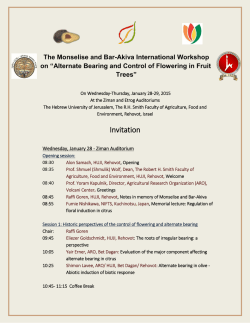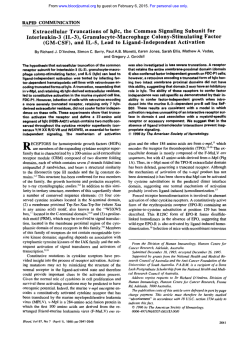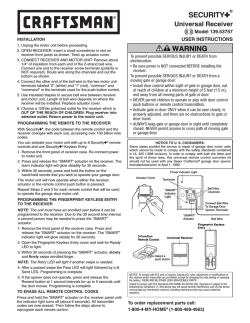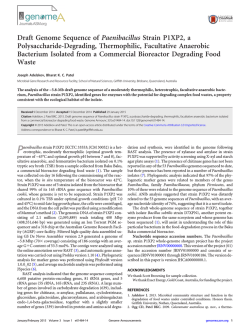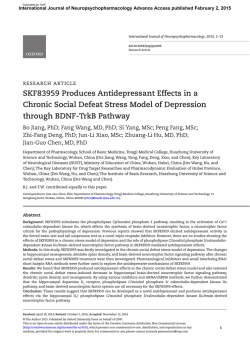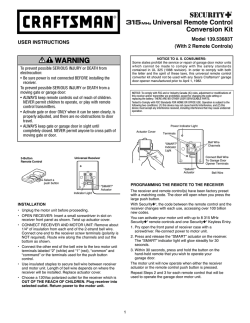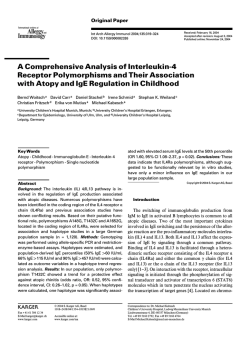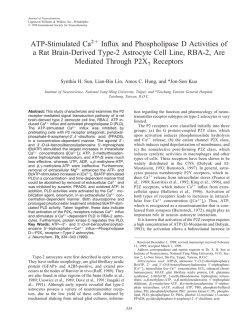
Brief Communication Strain differences and the role
Int J Mol Epidemiol Genet 2011;2(1):51-55 www.ijmeg.org /ISSN1948-1756/IJMEG1008003 Brief Communication Strain differences and the role of AT1 receptor expression in anxiety Bruno J. Golding1,2, Andrew D.J. Overall1, Paul R. Gard1 1School of Pharmacy & Biomolecular Sciences, University of Brighton, UK; 2Department of Basic Neuroscience, University of Geneva, Switzerland. Received August 26, 2010; accepted December 20, 2010; Epub December 26, 2010; published January 1, 2011 Abstract: This study investigated strain specific differences to the anxiolytic response to losartan focusing on genetic variation that may influence such responses. This included: AT1 receptor sequence variation, angiotensin II receptor associated protein (ATRAP) and receptor expression between strains. Sequencing of exon 3 of AT1aR revealed no differences between BKW mice (n=6) and C57 and DBA2 strains (n=3). Comparisons of AT1 expression do show significant differences, whereby BKW mice showed the highest levels of expression and DBA2 mice intermediate levels when compared to the C57 strain. Sequencing of sections of the Angiotensin receptor associated protein (ATRAP) identified a non-synonymous point mutation- (T/C) transversion (position 109-161) (SNP id = rs13467517) resulting in a Valine Alanine (V157A) amino acid change in the BKW and DBA2 strains. Our results indicate that the previously reported strain dependent effects are not due to variation in AT1a receptor sequence. Differences in AT1 gene expression levels between strains, which mirror their anxiety phenotype, are observed. This is coupled with a nonsynonymous single nucleotide polymorphism in ATRAP, a negative regulator of AT1 signalling. Keywords: AT1 receptors, anxiety, anxiolytic, strain differences, angiotensin receptor associated protein (ATRAP), losartan Introduction fects [8,9]. The AT1 receptor antagonists are reported to exert their anti-stress and anti-anxiety properties by modulating, in part, the HPA axis and three interacting cortical systems: CRF, GABA Type A receptors (GABAA), and noradrenaline [2]. Stimulation of AT1 receptors in the paraventricular nucleus (PVN) by angiotensin (Ang II) increases CRF production and is important for the induction of anxiety; indeed, CRF1 receptor antagonists have been shown to decrease stress-induced anxiety [6]. Ang II can also potentiate neurotransmission; hence, blockade of the Ang II system with specific antagonists may hyperpolarise the membrane potential of sympathetic neurons, resulting in normalisation of their activity. Further, AT1 receptor facilitates catecholamine release throughout the AT1 pre-synaptic receptor mechanism and blockade of this via losartan may have a beneficial anti-anxiety effect [10] The inhibition by AT1 receptor antagonists is sufficient to block stress-induced changes in CRF1 receptors and restores the inhibitory effect of the cortical GABAA system [7]. Importantly the CRF and GABA systems are tightly interconnected within the paraventricular nucleus, an area which contains high numbers of AT1 receptors and where losartan has been shown to cross the blood brain barrier and exert its ef- There is however, within-strain and inter-strain variation in the responses of rodents to various paradigms of anxiety which highlights an ‘order’ of anxiety, whereby some mice strains show higher levels of anxiety compared with others. Some strains, such as the C57BL/6, have been described as non-emotive, while the contrary has been described for DBA2, BALB/C and A/J mouse strains [11,12]. Observations of C57BL/6J and BALB/C also show that the former are non-anxious, while mice the latter are Strain differences and the role of AT1 receptor expression in anxiety much less active and generally more anxious [13]; suggesting that performance in the EPM and LD is markedly influenced by genetic variation between strains. The angiotensin receptor associated protein (ATRAP/AGTRAP) is known to act as a negative regulator of AT1 receptor signalling and is reported to potentiate Ang II signalling effects. Indeed, overexpression of ATRAP results in a marked decrease of agonist induced AT1A mediated activation of phospholipase C [14], reduces the number of AT1 receptors at the cell surface [15] and negatively regulates promoter transcription and protein synthesis. In this study strain differences to the anxiolytic response to losartan were investigated in mice focusing on areas of genetic variation that may influence strain specific responses. This includes: AT1 receptor sequence variation, the angiotensin II receptor associated protein (ATRAP) and receptor expression differences between strains. Materials ans methods Animal treatment and husbandry All behavioural experiments were licensed under the UK Scientific Procedures (Animals) Act, 1986. Male mice of each of strain (BKW, DBA2 and C57, 19-30g) were bred and reared inhouse under identical conditions, consisting of housing in North Kent M1/M2 cages on flake sawdust bedding in an air conditioned room (approx 19ºC +/- 1ºC; humidity 50% +/-10%) under a 14/10-h light/dark cycle, commencing 07:00 to 21:00. The subjects had free access to food and water. PCR PCR amplification was carried out using a Hybaid touchdown thermal cycler using standard thermal cycling conditions. PCR products were then electrophoresed on a 2% Agarose gel for 1 hour at 80V, stained and visualised using ethidium bromide. DNA samples were sequenced using the forward primer used for initial PCR by Cogenics UK (Primer details available upon request). Mice were sacrificed and had their brains immediately removed. Hypothalamic brain tissue was 52 used to isolate total RNA using the guanidine isothiocyanate enhanced TRIzol method (Invitrogen, UK). RNA integrity was determined spectrophotometrically and only RNA with a A260 \A280 ratio above 1.8 was used for reverse transcription. 1ug of RNA was treated with Turbo DNase I (Ambion) before being reverse transcribed using BIO-RAD Iscript RT PCR kit with random oligo(dT) primers. AT1R and Glyceraldehyde 3-phosphate dehydrogenase (GAPDH) gene expression was analysed using the 2(ΔΔCt) method [16]. Primers and probes were designed using Perlprimer [17] and were developed to span Intron/Exon boundaries and to ensure specificty to AT1a, by avoiding regions of high similarity and designing primers in the 5' untranslated region. The primers and probe were synthesised by MWG Biotech; n=3 in triplicate in all cases. Confirmation of product specificity by size was established by melt curve analysis and where agarose gel electrophoresis revealed single specific PCR products. The initial real-time PCR resulted in greater variance across replicates than anticipated. For this reason a subsequent duplication was performed. However, the nature of the ΔΔCt analysis does not lend itself readily to the simple addition of data from two independent observations, hence a simple Bayesian approach was employed, following the procedure outlined in Box & Tiao [18] and Quinn & Keough [19]. The mean and variance in ΔΔCt values from the first round of real-time PCR were used to set up the prior distribution, which was assumed to be normally distributed. The standardised likelihood function was normally distributed with the mean ΔΔCt value of the second round of realtime experiments and variance equal to the squared standard error of this mean. The mean of the posterior distribution is 1 n 2 0 2 y n s 1 s 2 0 2 s0 s 1 s 02 , is the estimate of the prior variance, s2 is the second 0 sample variance, is the mean of the prior y distribution and is the mean of the second sample. The variance of the posterior distribu- Int J Mol Epidemiol Genet 2011:2(1):51-55 Strain differences and the role of AT1 receptor expression in anxiety 1 2 tion is 1 n 2 2 s0 s . Data analysis and statistical comparisons Statistical comparisons were performed using Minitab 15 (Minitab Solutions). Bayesian analysis and RT-PCR calculations were analysed using Microsoft Excel (Microsoft). P<0.05 was considered statistically significant Figure 2. Diagrammatic representation of ATRAP V157-A mutation in C57, DBA2 and BKW mice. BKW and DBA2 mice differ from C57 strains resulting in a Valine to Alanine substitution at position 157. (n=6). Results AT1 sequencing Sequencing of exon 3 of AT1ΔΔR which contains the entire open reading frame (MGI:87964) revealed no differences between BKW mice (n=6) and the reference C57 and DBA2 strains (n=3) . Comparisons of the sequencing data using ClustalW alignment showed that AT1 R sequence was identical between strains. AT1 RT-PCR expression analysis The posterior probability distributions of mean values are given in Figure 1. Comparisons of C57 and BKW show significant differences between strains, represented by the nonoverlapping 95% confidence intervals. In summary C57 shows significantly different AT1R expression levels to the BKW strain. Figure 3. A. Representative sequence data of ATRAP in C57 strain. B. Representative sequence data of a mutation in ATRAP. DBA2 and BKW strains show T/C base transversion. ATRAP- Functional mutation A-V hydrophilic tail domain (position 109-161) (SNP id = rs13467517). This results in a Valine Alanine (V157A) amino acid change in the BKW and DBA2 strains (Figure 2 and 3). ΔΔCt Sequencing of ATRAP hydrophilic domains identified a non-synonymous point mutation resulting in (T/C) transversion at position 157 in the Figure 1. Posterior probability distributions for the mean DDCt values across strains. 53 Discussion The anxiolytic effect of AT1 antagonists has been demonstrated in rodents by several groups [3,4,5,10,20) although some effects are reported as strain specific. The results presented herein demonstrate that the previously reported strain dependent effects are not due to variation in AT1a receptor sequence. However, differences in AT1 gene expression levels between strains are observed whereby BKW and DBA2 strains show higher expression compared to C57, which mirrors their anxiety phenotype. This is coupled with a non-synonymous Int J Mol Epidemiol Genet 2011:2(1):51-55 Strain differences and the role of AT1 receptor expression in anxiety single nucleotide polymorphism in ATRAP, a negative regulator of AT1 signalling. The findings in this study show that AT1 receptor sequence is identical between strains and, while no differences in AT1 receptor sequence were observed, RT-PCR expression analysis of hypothalamic AT1 receptors revealed differences in expression: BKW mice showed the highest levels of expression and DBA2 mice an intermediate level, when compared to the C57 strain In previous studies by Gard et al, [5] BKW mice showed the highest anxiety‑like behaviour in the L/D and EPM test followed by DBA2 and C57. These observations are consistent with others where the C57 strain are reported as “low anxiety” with significantly lower anxiety than DBA2 mice [12, 21] . The low level of anxiety in C57 mice and the higher levels of anxiety in DBA2 and BKW mice mirror the expression levels of AT1 receptors found in this study; suggesting that the more anxious strains exhibit higher levels of AT1 receptor expression. Such differences in the protein level of AT1 receptors would also be of interest as well as possible effects of post-translational modifications in these strains. The previous strain dependent effect, whereby losartan is only effective in the BKW strain, may represent an effect due to the higher levels of anxiety inherently displayed by this strain, perhaps due to this increased AT1 expression. Whether higher AT1 expression in the BKW strain results in an anxious phenotype or whether increased anxiety is due to increased upregulation of AT1 receptors remains unresolved; however overexpression of AT1 receptors in mice lacking AT2 receptors is linked with anxiety-like behaviour [22]. In contrast, the phenotype of AT1 -/- mice may also be of interest in determining the role of these receptors in anxiety. The use of more than one strain, when testing the mechanism and the role of AT1 antagonists, is not typical of this literature, possibly explaining why the correlation between AT1 expression and an anxious phenotype may not have been identified previously. It is interesting to note that in the previous study by Gard et al, [5] the C57 and DBA2 54 strains showed similar contractile responses to Ang II, while the BKW strain showed a significant reduction. ATRAP is associated with reduced Ang II signalling and this study has identified that both DBA2 and BKW mice posses a non-synonymous polymorphism (rs13467517) in this gene. ATRAP modifies Ang II receptor signalling in vitro and in DBA2 and BKW mice the SNP results in a non-synonymous Valine to Alanine amino acid change at position 157 of the hydrophilic domain of the protein. The precise effect of this polymorphism is unknown, and is only observational but it is tempting to speculate that the higher expression of AT1 receptors in DBA2 and BKW, in contrast to C57 mice, is linked to this polymorphism. At present the discrete localisation of ATRAP is unknown, although low levels have been identified in the brain [14]. Perhaps increased AT1 receptor expression also results in increased ATRAP expression. Functional differences in ATRAP also provide a possible explanation of the strain differences observed in contractile effects of Ang II in isolated tissue. Despite showing no variation in receptor structure, contractile effects were reduced in BKW strains. Owing to the presence of the ATRAP-SNP in DBA2 strains, it would be expected that the reduced contractile effect would also be observed in this strain. However, DBA2 and C57 mice showed comparable contractile effects, perhaps due to signalling by another mechanism resulting in a compensational loss in signalling. In agreement with previous studies AT1 receptors appear to be implemented in anxiety like behaviour. The previously identified strain differences and the “order” of anxiety seen within and between strains may be attributed to variation in AT1 expression levels, where more anxious animals show higher AT1 expression. Whether the changes in AT1 expression are mediated by the functional mutation in ATRAP, are due to posttranslational modifications or variability in protein levels or linked to SNPs in the promoter region was not specifically investigated in this study. Importantly, current treatments focus on serotonin, dopamine and noradrenaline in the brain and their efficacy and response rate has not improved despite the development of newer drugs [23]. Data show that specific antagonism of AT1 receptors reduces anxiety and therefore Int J Mol Epidemiol Genet 2011:2(1):51-55 Strain differences and the role of AT1 receptor expression in anxiety suggests that levels of AT1 expression have an important role. Whether AT1 expression is the critical mediator of anxiety and whether higher AT1 receptor expression is indicative of an anxious phenotype warrants further research. Please address correspondence to: Dr. BJ Golding, Department of Neuroscience, University of Geneva, Switzerland. E-mail: [email protected] References [1] Pavel J, Benicky J, Murakami Y, Sanchez-Lemus E, Saavedra JM. Peripherally administered angiotensin II AT1 receptor antagonists are antistress compounds in vivo. Ann N Y Acad Sci 2008; 1148:360-6. [2] Saavedra JM, Armando I, Bregonzio C, Juorio A, Macova M, Pavel J, Sanchez-Lemus E. A centrally acting, anxiolytic angiotensin II AT1 receptor antagonist prevents the isolation stressinduced decrease in cortical CRF1 receptor and benzodiazepine binding. Neuropsychopharmacology. 2006; 31(6): 1123-34. [3] Saavedra JM, HAndo H, Armando I, Balardi G, Bregonzio C, Juorio A, Macova M. Anti-stress and anti-anxiety effects of centrally acting angiotensin II AT(1) receptor antagonists. Regul Pept 2005; 128(3): 227-238. [4] Barnes NM, B Costall, Kelly ME, Murphy DA, Naylor RJ. Anxiolytic-like action of DuP753, a non-peptide angiotensin II receptor antagonist. Neuroreport 1990; 1(1): 20-1. [5] Gard PR, Haigh SJ, Cambursano PT, Warrington CA. Strain differences in the anxiolytic effects of losartan in the mouse. Pharmacol Biochem Behav 2001: 69(1-2): 35-40. [6] Holsboer F and Ising M. "Central CRH system depression and anxiety -Evidence from clinical studies with CRH1 receptor antagonists." Eur J Pharmacol 2008; 583(2-3): 350-357. [7] Nutt D and Malizia L. New insights into the role of GABAA benzodiazepine receptor in psychiatric disorder. Br J Psychiatry 2001; 179: 390-396. [8] Li Z, Bains JS, and Ferguson AV. Functional evidence that the angiotensin antagonist losartan crosses the blood-brain barrier in the rat. Brain Res Bull 1993; 30(1-2): 33-39. [9] Polidori C, Ciccocioppo R, Pompei P, Cirillo R, Massi M. Functional evidence for the ability of angiotensin AT1 receptor antagonists to cross the blood-brain barrier in rats. Eur J Pharmacol 1996; 307(3): 259-267. [10] Srinivasan J, Suresh B, Ramanathan M. Differential anxiolytic effect of enalapril and losartan in normotensive and renal hypertensive rats. Physiol Behav 2003; 78(4-5): 585-591. [11] Belzung C and G Griebel . Measuring normal and pathological anxiety-like behaviour in mice: a review. Behav Brain Res 2001; 125(1-2):141- 55 149. [12] DuBois DW, Perlegas A, Floyd DW, Weiner JL, McCool BA. Distinct functional characteristics of the lateral/basolateral amygdala GABAergic system in C57BL/6J and DBA/2J mice. J Pharmacol Exp Ther 2006: 318(2): 629-40. [13] Rodgers RJ, Boullier E, Chatzimichalaki P, Cooper GD, Shorten A. Contrasting phenotypes of C57BL/6JOlaHsd, 129S2/SvHsd and 129/ SvEv mice in two exploration-based tests of anxiety-related behaviour. Physiol Behav 2002; 77(2-3): 301-310. [14] Daviet L, Lehtonen JY Tamura K, Griese DP, Horiuchi M, Dzau VJ. Cloning and charaterization of ATRAP, a novel protein that interacts with the angiotensin II type 1 receptor. J Biol Chem 1999; 274(11): 17058-17062. [15] Tanaka Y, Tamura K, Koide Y, Sakai M, Tsurumi Y, Noda Y, Umemura M, Ishigami T, Uchino K, Kimura K, Horiuchi M, Umemura S. The novel angiotensin II type 1 receptor (AT1R)associated protein ATRAP downregulates AT1R and ameliorates cardiomyocye hypertrophy. FEBS letters 2005; 79(7): 1579-1586. [16] Livak KJ and Schmittgen TD. Analysis of relative gene expression data using real-time quantitative PCR and the 2(T)(-Delta Delta C) method. Methods 2001;25(4): 402-408. [17] Marshall O. PerlPrimer: cross-platform, graphical primer design for standard, bilsulphite and real-time PCR. Bioinformatics 2004; 20(15): 2471-2472. [18] Box GEP and Tiao GC. Bayesian Inference in Statistical Analysis. New York,Wiley,1973, pp. 10-18. [19] Quinn GP and Keough MJ: Experimental Design and Data Analysis for Biologists. Cambridge, 2002, pp. 27-31. [20] Braszko JJ, Kulakowska A, Winnicka, MM. Effects of angiotensin II and its receptor antagonist on motor activity and anxiety in rats. J Physiol Phatmacol 2003; 54(2):271-281. [21] Brodkin ES, Carlezon WA, Halle CN, Kosten TA, Heninger GR, Nestler EJ. Genetic analysis of behavioural, neuroendocrine and biochemical parameters in inbred rodents: intial studies in Lewis and Fisher 344 rats and in A/J and C57BL/6J mice. Brain Res 1998; 14(805): 5568. [22] Okuyama S, Sakagawa T, Chaki S, Imagawa Y, Ichiki T, Inagami T. Anxiety-like behavior in mice lacking the angiotensin II type-2 receptor. Brain Res 1999; 821(1): 150-159. [23] Annetrude J.G. de Mooij-van Malsen, Berend Olivier and Martien J.H. Kas. Behavioural genetics in mood and anxiety; A next step in finding pharmacological targets. Eur J Pharmacol 2008; (585) 436-440. Int J Mol Epidemiol Genet 2011:2(1):51-55
© Copyright 2025
